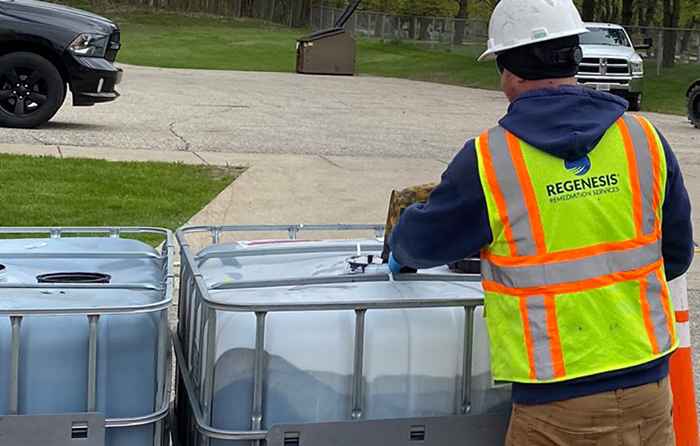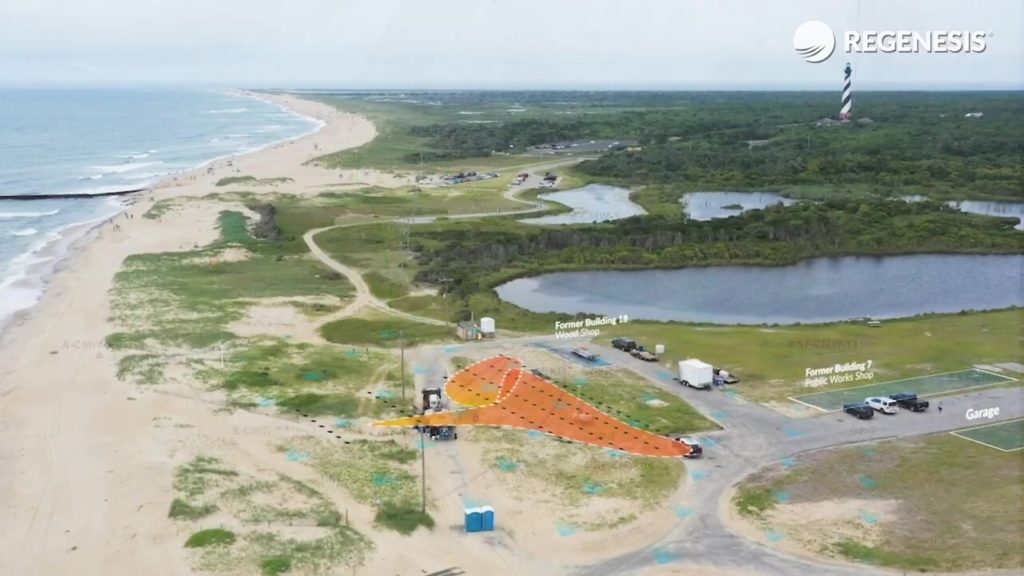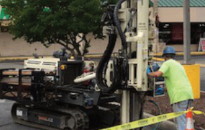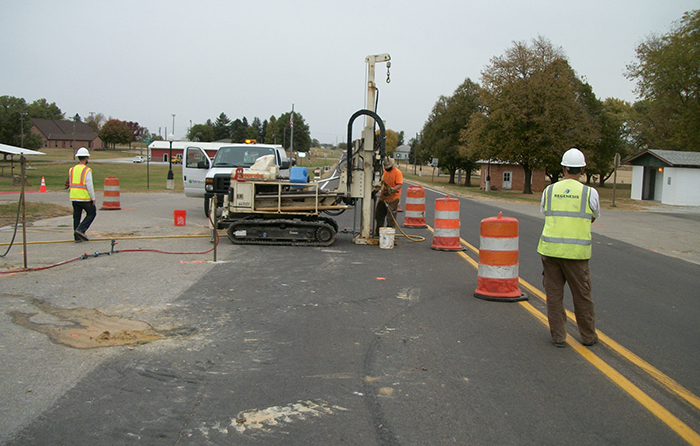Multiple Lines of Evidence Show CVOCs Degrading on PlumeStop, Leading Site to NFA Status
This case study reviews one of the original PlumeStop® pilot tests for in situ groundwater treatment of chlorinated volatile organic compounds (CVOCs or chlorinated solvents) at a former dry cleaner location in Marina, California. REGENESIS treated the CVOCs using a novel, sorption-enhanced reductive dechlorination (ERD) approach. This approach consisted of immediate sorption followed by the sequential elimination of chlorine from the CVOC molecules, transforming them into non-toxic end products such as ethene, carbon dioxide, and chloride.
Case study highlights:
- Combined remedy approach proves successful in treating chlorinated solvents at former dry cleaner
- This site provided ideal challenge conditions to demonstrate complete biodegradation using a sorption-ERD approach
- The site was granted NFA status in June 2019 as a result of this pilot study
9m 31s reading time
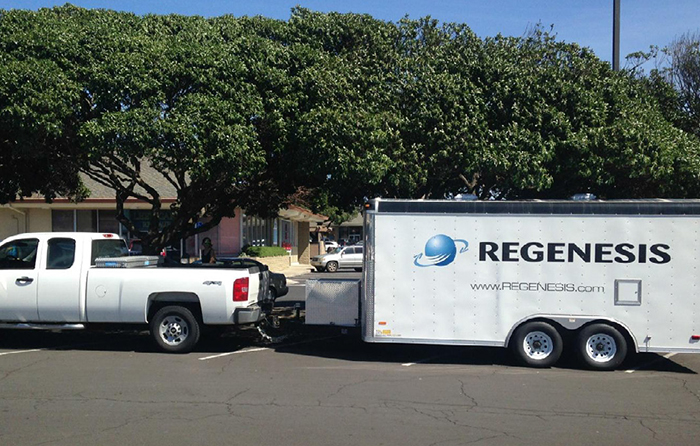
Colloidal Activated Carbon Barrier Protects Neighborhood from Chlorinated Solvent Plume
This case study reviews a field-scale pilot test for in situ groundwater treatment of chlorinated volatile organic compounds (CVOCs) at high concentrations, in a fast-moving, aerobic aquifer beneath a residential neighborhood. The CVOCs were treated using a unique combination of remediation technologies, symbiotically promoting sorption-enhanced reductive dechlorination (ERD) via biotic and abiotic processes. Hamp, Mathews & Associates, Inc., a leading environmental consultant, enlisted REGENESIS to design and install an in situ PRB to fully treat the tetrachloroethene (PCE), trichloroethene (TCE), cis-1,2-DCE (cis-DCE), and vinyl chloride, converting them into nontoxic end products such as ethene, ethane, carbon dioxide, and chloride.
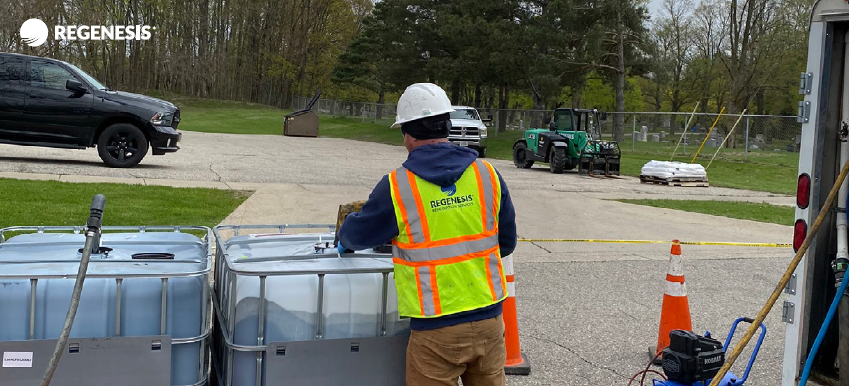
Case study highlights:
- A combined remedy approach using activated carbon and zero valent iron reduces risk of exposure to a residential neighborhood
- PlumeStop permeable reactive barrier (PRB) demonstrated effective in eliminating contaminants in an extreme contaminant flaux aenvironment
- Soil cores and groundwater samples confirmed consistent PlumeStop distribution in the in situ PRB
11m 59s reading time
Petrofix Applied At Regional Airport Site To Treat BTEX
A Petroleum hydrocarbon release caused by leaking underground storage tanks (USTs) required remediation at the Dare County Regional Airport in Outer Banks, North Carolina.
After the leak was discovered in 2008, a contractor removed two 50,000-gallon concrete underground storage tanks and four steel USTs that were previously used to store fuel at the site. Additionally, 455 tons of hydrocarbon-impacted soil and approximately 300 tons of sludge were excavated during the tank closure activities. Sampling performed at the time of the UST closures identified hydrocarbon-impacted soil at the locations of the concrete tanks and along the fuel distribution pipe.
Case study highlights:
- This former Naval Auxiliary Air Station site is one of three sites in the region where PetroFix has been applied to address PAHs
- After years of monitoring and remediation attempts, PetroFix was chosen because of its proven ability to reduce petroleum contaminants and ensure site closure
- Visual confirmation in soil cores and monitoring wells allows the field crew to make real-time adjustments to ensure proper distribution
- PetroFix is being used on other CERCLA/RCRA-funded sites to quickly reduce contaminant levels and accelerate site closure
10m 7s reading time

Performance-Based Objectives Achieved at Scott AFB
This case study reviews the Corrective Action Plan (CAP) at Scott Air Force Base, a large military base located in Southwestern Illinois that was contaminated with petroleum impacted soil. One month following the application of PetroFix®, contaminant levels reached non-detect. Benzene continued to remain non-detect through March 2020 and the site was recommended for no further action.
The final CAP Addendum proposed two rounds of groundwater treatment by injection at Former Tank 85 to reduce benzene concentrations below the groundwater remediation objectives. The first round of injections was completed in February through March 2018 and consisted of the use of REGENESIS’ RegenOx®, coupled with ORC Advanced® to stimulate aerobic bioremediation. The initial injection was successful in reducing most contaminants within the affected area. The second round of injections at the former UST was completed in March 2019 using REGENESIS’ PetroFix micron-scale remedial fluid.

Case study highlights:
- Impacted soil was caused by leaking underground piping and removal of two large UST’s
- Second round of direct push injections included PetroFix to treat lingering BTEX
- One month following application of PetroFix, BTEX levels were at non-detect and have continued to remain at that level for 5 sampling events
5m 25s reading time
Performance-Based Objectives Achieved at Scott AFB
This case study reviews the Corrective Action Plan (CAP) at Scott Air Force Base, a large military base located in Southwestern Illinois that was contaminated with petroleum impacted soil. One month following the application of PetroFix®, contaminant levels reached non-detect. Benzene continued to remain non-detect through March 2020 and the site was recommended for no further action. The final CAP Addendum proposed two rounds of groundwater treatment by injection at Former Tank 85 to reduce benzene concentrations below the groundwater remediation objectives. The first round of injections was completed in February through March 2018 and consisted of the use of REGENESIS’ RegenOx®, coupled with ORC Advanced® to stimulate aerobic bioremediation. The initial injection was successful in reducing most contaminants within the affected area. The second round of injections at the former UST was completed in March 2019 using REGENESIS’ PetroFix micron-scale remedial fluid.

Case study highlights:
- Impacted soil was caused by leaking underground piping and removal of two large UST’s
- Second round of direct push injections included PetroFix to treat lingering BTEX
- One month following application of PetroFix, BTEX levels were at non-detect and have continued to remain at that level for 5 sampling events
5m 25s reading time
NFA Status Achieved at Virginia Gas Station Site
This case study reviews a former retail fueling center in Virginia where Sovereign Consulting was hired to demolish the site and remove a 25,000 gallon underground storage tank (UST) which was also the source of the LNAPL contamination. Working with the Virginia Department of Environmental Quality (VADEQ) Sovereign conducted a Site Characterization Assessment and following monitoring was then retained by their client to demolish the fueling center and remove the 25,000-gallon gasoline UST and the associated fueling system which represented the source of the contamination.
Once the source of contamination (UST) and the free-product was addressed, Sovereign worked with REGENESIS to formulate and execute a groundwater remediation plan that used PetroFix. Unlike other groundwater treatment materials, PetroFix was utilized due to its dual function – it quickly removes hydrocarbons from the dissolved phase by absorbing them onto the activated micro-carbon particles and the electron acceptors promote hydrocarbon biodegradation in situ to encourage continued remediation. This combination resulted in a rapid decreases in contamination in weeks as opposed to months as determined through monitoring well groundwater sampling and the corresponding concentration curves for each chemical of concern.
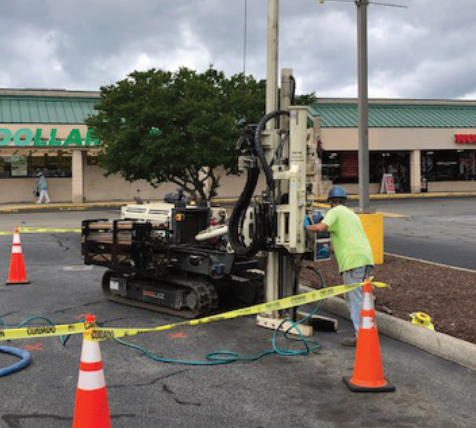
Case study highlights:
- PetroFix quickly reduced BTEX, Naphthalene, and THP-GRO Concentrations to reach site goals
- Pollution Complaint Case Closure granted by the VADEQ in less than one year post-application
- Single application of PetroFix addressed contaminants of concern to help site reach closure
5m 2s reading time
PlumeStop Arrests PCE in Fast Moving Aquifer
This case study reviews a former dry-cleaning site in Martinsville, Indiana that had a perchloroethylene (PCE) release which contaminated the community’s groundwater with concentrations in excess of 370 parts per billion (ppb). The sand and gravel aquifer created a challenging problem due to the high flow regime, with a groundwater velocity of approximately 1,560 ft/year and oxygenated geochemistry which had limited natural attenuation. After a thorough evaluation of possible technologies, environmental consulting firm Wilcox Environmental Engineering determined that PlumeStop® Liquid Activated Carbon™ in combination with HRC® and BDI Plus® could prevent the plume from migrating and would work in the well-oxygenated, sand and gravel lithology.
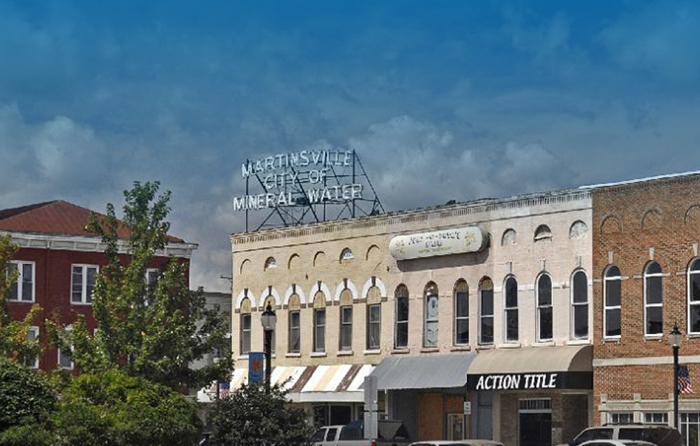
Case study highlights:
- PlumeStop effectively treated the plume in the well-oxygenated, sand and gravel lithology
- 99% reduction of PCE ~30 days after the application in key monitoring wells
- Demonstration of PRB leading to full-scale treatment in Spring 2020
6m 44s reading time
Global Retailer Enters Into Elective Site Cleanup Agreement and Achieves NFA
This case study reviews the site of a global retailer based in Arkansas, where historic offsite dry cleaning operations caused tetrachloroethylene (PCE) contamination in the groundwater. A previous bioremediation attempt successfully remediated a majority of the site but one persistent well remained. After time passed with little change to the B-45 well, ESGI sought out a bioremediation strategy that would work quickly with long term success. ESGI partnered with REGENESIS to design a bioremediation plan that would apply PlumeStop®, Liquid activated Carbon, Hyrdogren Release Compound® (HRC) and Bio-Dechlor Inoculum® (BDI Plus) to eliminate the remaining contaminants of concern (COCs). After the applications of PlumeStop, HRC, and BDI Plus, all COCs were below the acceptable threshold levels, and as a result the site achieved No Further Action (NFA) in January of 2020.

Case study highlights:
- PlumeStop, HRC, and BDI Plus successfully remediated persistent PCE, VC, and Cis-1,2-DCE contamination.
- Environmental services firm ESGI and REGENESIS adapted the injection design according to the difficult site geology and weather conditions.
- After one round of injections, successful results led to the site achieving NFA.
6m 3s reading time
Petroleum Hydrocarbon Plume Treated to Non-Detect within 50 Days
This case study reviews an active gas station in Nebraska that was adversely impacted by a dissolved‑phase, hydrocarbon plume. The treatment solution from REGENESIS was successful in reducing the concentrations of BTEX, TPH-G, and MTBE to non-detect levels. REGENESIS conducted a thorough and innovative DVT program prior to remediation in order to ensure an effective remedial design. They used the DVT to produce a design which fit the precise needs of the site as well as the client’s budget. After the successful treatment, the consultant continued to monitor the groundwater trends until the Nebraska Department of Environment and Energy (NDEE) granted the site closure status. The on-site gas station has remained open for business.
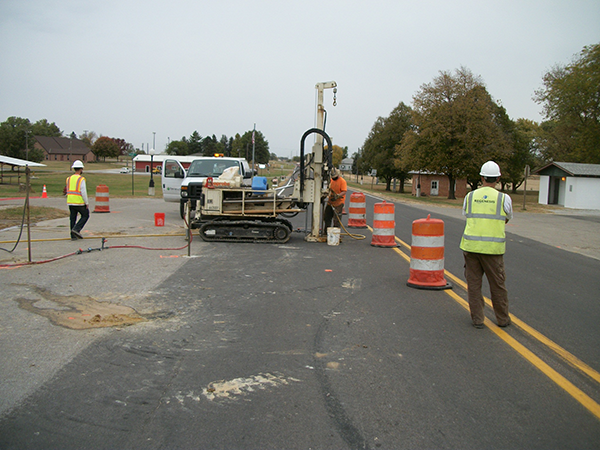
Case study highlights:
- Thorough Design Verification Testing (DVT) program helped to create a unique design for effectively treating the contaminant plume.
- Cost-effective design and application required a single application event.
- The remedial approach successfully treated a 200 ft. long dissolved phase hydrocarbon plume within the first 50 days.
6m 52s reading time
Excavation With RegenOx Successfully Treats Large PHC Plume
This case study reviews a former gas station site in Buffalo, New York that required remediation due to leaking underground storage tanks. Together with REGENESIS, C&S Consulting designed an in situ remediation strategy to target the residual contaminant plume. RegenOx® in situ chemical oxidant was chosen because of its ability to target petroleum hydrocarbons and its non-corrosive properties. As part of the New York State Department of Environmental Conservation (NYSDEC) Brownfield Cleanup Program, C&S designed a complex remediation program to ensure a quick and affordable solution. Petroleum contamination extended from 10 to 40 feet below grade. The site was excavated to 26 feet below ground surface to remove residual contamination and to enable equipment staging and material handling areas to support the deeper excavation area.

Case study highlights:
- After previous consultants attempted remediation without success, C&S created a remediation strategy that successfully reduced the plume.
- The combined remedy approach of excavation and ISCO exceeded the remediation goals.
- Successful remediation enabled the construction of a 350,000 sq. ft. $110 million facility at the Buffalo Niagara Medical Campus.

 Americas
Americas Europe
Europe Français
Français Deutsch
Deutsch Italiano
Italiano Español
Español